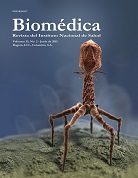Estimation of Aedes aegypti (L.) (Diptera: Culicidae) productivity in households and public spaces in a dengue endemic city in Colombia
Abstract
Introduction: Aedes aegypti is a vector for the dengue virus in Colombia. Its productivity can be estimated using pupal counts.
Objective: To determine Ae. aegypti productivity in households and public spaces in Girardot (Colombia) during both wet and dry seasons.
Materials and methods: The amount of Ae. aegypti pupae was evaluated in 20 randomly selected clusters in Girardot, each consisting of 100 households and public spaces. Inspections were performed during the rainy (February-May, 2011), and dry (August-September, 2011) seasons. House, container, Breteau, person and hectare pupae indices were estimated.
Results: During the rainy season households contributed 94% to the total number of pupae (n=7,098) while only 6% (n=482) were found in public spaces. In the dry season, 98% (n=9,138) of pupae were found in households and 2% (n=223), in public spaces. Low water-storage tanks and tanks for washing purposes provided >87% of pupae in households, whereas jars, tires and sinks contained most pupae in public spaces. High pupal densities were observed in public spaces during the rainy season and in streets and schools in the dry season. There were no significant differences in the index per person (rainy season=1.0; dry season=1.3) or per hectare (rainy season=0.96, dry season=0.45) between seasons.
Conclusions: High Ae. aegypti pupal densities were found inside households in low water-storage tanks and tanks for washing purposes during both the dry and rainy seasons. Public spaces provided more aquatic habitats during the rainy season. Vector control strategies targeting these containers could allow a more rational use of resources and increase efficiency.
Downloads
Some similar items:
- Érika Patricia Alarcón, Ángela María Segura, Guillermo Rúa-Uribe, Gabriel Parra-Henao, Ovitraps evaluation for surveillance and control of Aedes aegypti in two urban settlements of Urabá, Antioquia , Biomedica: Vol. 34 No. 3 (2014)
- Freddy Ruiz-López, Ana González-Mazo, Andrés Vélez-Mira, Giovan F. Gómez, Luisa Zuleta, Sandra Uribe, Iván Darío Vélez-Bernal, Presence of Aedes (Stegomyia) aegypti (Linnaeus, 1762) and its natural infection with dengue virus at unrecorded heights in Colombia , Biomedica: Vol. 36 No. 2 (2016)
- Laura Cabezas, Wilson Cabanzo, Fernando Santa, Victor Alberto Olano, Diana Sarmiento, Sandra Vargas, Juan Felipe Jaramillo, Thor-Axel Stenstrom, Hans J. Overgaard, María Inés Matiz, Spatial distribution of Aedes aegypti (Diptera: Culicidae) in the rural area of two municipalities of Cundinamarca, Colombia , Biomedica: Vol. 37 No. Sup. 2 (2017): Suplemento 2, Entomología médica, 2017
- Berta Nelly Restrepo, Margarita Arboleda, Ruth Ramírez, Gonzalo Álvarez, Serum platelet-activating factor acetylhydrolase activity in dengue patients of African or mestizo descendency , Biomedica: Vol. 31 No. 4 (2011)
- César A. Rodriguez, Diana C. Gallego, José A. González, Paola A. Luna, Mitzilene Navarro, Germán A. Ramírez, Mosquitoe breeding sites and fauna ln Armenia's urban area aiier the January 25, 1999, earthquake , Biomedica: Vol. 21 No. 2 (2001)
- Sandy Milena Caldera, María Cristina Jaramillo, Suljey Cochero, Alveiro Pérez-Doria, Eduar Elías Bejarano, Genetic differences between populations of Aedes aegypti from municipalities in northern Colombia, with high and low dengue incidence , Biomedica: Vol. 33 (2013): Suplemento 1, Fiebres hemorrágicas
- Tania Camacho, Fernando de la Hoz, Victor Cárdenas, Carmen Sánchez, Laura de Calderón, Ligia Pérez, Antonio Bermúdez, Incomplete surveillance of a dengue-2 epidemic in Ibagué, Colombia, 1995-1997. , Biomedica: Vol. 24 No. 2 (2004)
- Ronald Maestre, Consuelo Vergara Sanchez, Guillermo Berrueco Rodríguez, Betsy Bello Novoa, Helena Brochero, Presence of Haemagogus equinus Theobald, 1903 (Diptera: Culicidae), in Soledad and Malambo, in the Province of Atlántico, Colombia , Biomedica: Vol. 28 No. 1 (2008)
- Clara Beatriz Ocampo, Camila González, Carlos A. Morales, Mauricio Pérez, Dawn Wesson, Charles S. Apperson, Evaluation of community-based strategies for Aedes aegypti control inside houses , Biomedica: Vol. 29 No. 2 (2009)
- Larry Niño, Use of the function semivariogram and kriging estimation in the spacial analysis of Aedes aegypti (Diptera: Culicidae) distributions , Biomedica: Vol. 28 No. 4 (2008)
| Article metrics | |
|---|---|
| Abstract views | |
| Galley vies | |
| PDF Views | |
| HTML views | |
| Other views | |


























